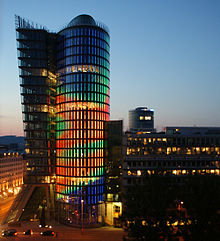Light architecture

The term light architecture was coined in 1926 by the natural scientist Joachim Teichmüller .
Teichmüller used the term in one of his essays and at an exhibition by the Light Technology Institute (LTI) at the Technical University of Karlsruhe . He wanted to point out the differences between architectural light and light architecture. While, in his opinion, architectural light ensures that buildings are evenly illuminated, light architecture is artificial light that emphasizes architectural elements. At the “lighting technology exhibition” as part of the GeSoLei exhibition in Düsseldorf, the term was first “written on a wall in large letters”.
Function and effect
The architecture of a building is emphasized by the lighting architecture and disappears again without direct lighting. The facade lighting highlights architectural features and reinforces the shadows and contours of the individual components and structural elements, such as bay windows , risalits , cornices, pilaster strips or the like.
The lighting architecture aims to maximize the effect of the night lighting and to harmonize the surrounding individual elements, such as neon signs , illuminated advertising , floodlights and spotlights . An architectural example of the effects of light architecture are the Cologne Cathedral or the Brandenburg Gate in Berlin.
literature
- Otto Firle : light architecture . In utility graphics issue 9/1931 ( digitized version )
- Walter Köhler, Wassili Luckhardt : Light architecture - light and color as spatial elements. Bauwelt Verlag, Berlin 1956